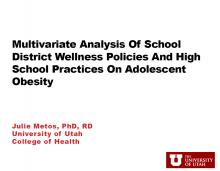We are pleased to announce an exciting new alliance between Active Living Research and GP RED to co-host and coordinate...
A Multivariate Analysis of School District Wellness Policies and High School Practices on Adolescent Obesity

Presentation at the 2013 Active Living Research Annual Conference.
Background and Purpose
In the United States, 18.1% of adolescents are obese and 34.2% are overweight or obese. Obesity in adolescence is the single best predictor of adult obesity. The Child Nutrition and WIC Reauthorization Act of 2004 (CNRA) is the most comprehensive national strategy to address youth obesity prevention in schools. The CNRA requires school districts to develop written wellness polices that address goals for physical activity, nutrition education, foods sold at school and other school based wellness activities. This legislation provides a unique opportunity to determine whether alterations are implemented in the high school environment as a result of district policy guidelines and if they are associated with the prevalence of overweight and obesity among adolescents. Evaluation of past policy efforts can inform future local, state and federal youth obesity prevention initiatives.
Objectives
The objective of this study was to assess the association of school wellness practices with adolescent overweight and obesity while controlling for individual, family and school characteristics. It was hypothesized that adolescents living within the boundaries of high schools reporting nutrition and physical activity practices would have a lower relative risk of overweight and obesity. It was further hypothesized that high school practices would be associated with school district wellness policy content.
Methods
School nutrition and physical activity practices were obtained from the 2004, 2006 and 2008 School Health Profiles surveys. Profiles is a biennial survey administered by the Centers for Disease Control and Prevention. Adolescent and family attributes were obtained from the Utah Population Database (UPDB), a compilation of genealogic and administrative records of Utah residents including driver’s licenses and birth certificates. School characteristics were accessed via the Common Core of Data (CCD). The CCD is an annual compilation of demographic data from each school in the United States collected by the Department of Education. School district wellness policies were obtained in 2006 and 2008 and evaluated for compliance with the CNRA. Further, when there was policy language addressing a requirement, the content was characterized as either “mandated” or “recommended.” Each adolescent was linked to their high school based on the address listed on their driver’s license. School boundary maps were used to create a geo-referenced data layer using ArcGIS© (version 9.3). The addresses were geo-coded and spatially joined to the school boundary data to identify the individual’s high school. Each geo-coded student was then linked to the results of the Profiles survey based on school and the year they received their driver’s licenses. Students whose school did not participate in Profiles for the time period they received their driver’s license were not included, resulting in a final sample of 51,162 Utah adolescents. Bivariate and multinomial analyses were performed to model the relationship of school practices among normal weight, overweight and obese adolescents while controlling for individual, family and school characteristics.
Results
Of the 42 high school practices examined, only exempting students from PE was associated with the risk of obesity (RRa=0.76, 95% CI: 1.16-1.74, p<0.02). Individual, family and school attributes were significantly associated with high BMI. Maternal obesity tripled the risk adolescent overweight (RRa=3.08, 95% CI: 2.54-3.76, p<0.001) and resulted in a six-fold risk of obesity (RRa=6.06, 95% CI: 4.988-7.52, p<0.001). American Indian adolescents had twice the risk of obesity (RRa= 2.09, 95% CI: 0.91-4.80, p <0.01) and Black adolescents had almost four times the risk of overweight when compared to White adolescents (RRa=3.80, 95% CI: 1.37-10.48, p<0.01). When the population of a high school was <70% -White, the risk of adolescent obesity was greater than in a less diverse school (RRa=1.43, 95% CI: 1.16-1.74, p<0.01). School practices were not related to their district having a mandatory policy related to that practice.
Conclusions
Overall, the implementation of physical activity and nutrition practices in high schools was not associated with adolescent overweight or obesity in Utah. Research is needed to develop tools that further quantify wellness policy efforts, especially as new federal guidelines are implemented as a result of the Healthy and Hunger Free Kids Act. This study suggests that the CNRA wellness policy mandate did not translate to increased emphasis on physical activity or nutrition in high schools. Future policy efforts ought to focus on successful implementation strategies for the complex high school environment. Finally, this study confirms that school wellness policy efforts should incorporate family involvement and prioritize racial and ethnic minority youth at the highest risk of overweight and obesity.
Support / Funding Source
University of Utah College of Health
- DOWNLOAD "2013_ChildcareHighSchool_Metos.pdf" PDF (0.37 MB) Presentations
STAY UP TO DATE
RECENTLY ADDED TOOLS & RESOURCES
MOVE! A BLOG ABOUT ACTIVE LIVING
The "Active Living Conference" aims to break down research and practice silos and...








